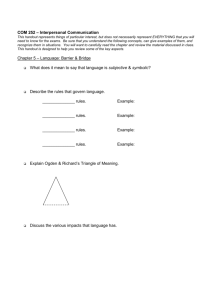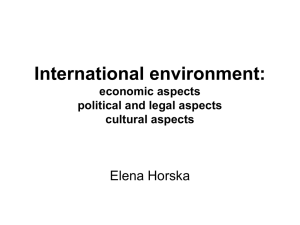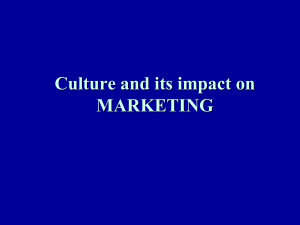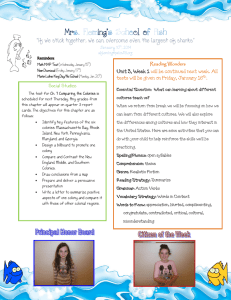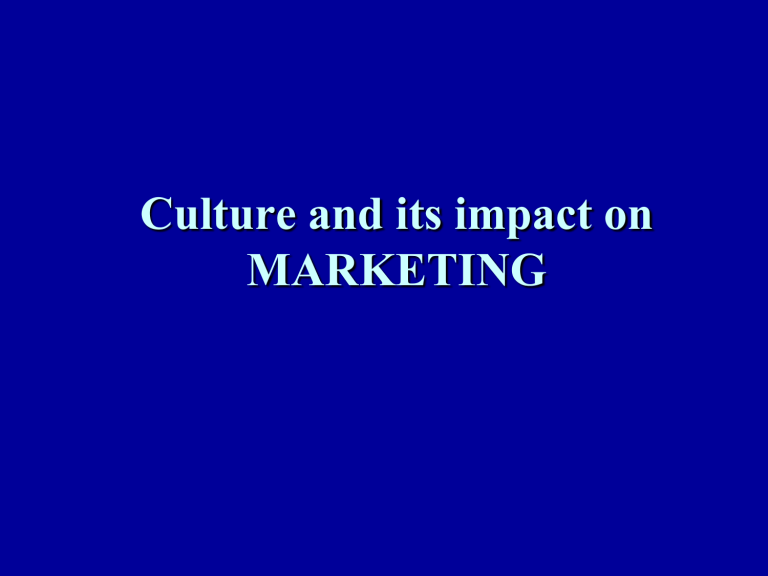
Culture and its impact on MARKETING EPRG Model - Characteristics Ethnocentric Polycentric Each country is relatively independent Geocentric Approach International operations are secondary The world is one common market Vision Centered on the Each market is domestic unique market Global vision of the world Priority Searching for identical segments in foreign markets Taking into consideration differences in foreign markets Unifying differences in the world market Planning center National headquarters Subsidiary in each country World headquarters Structure International Division for Matrix structure EPRG Model - Characteristics Ethnocentric Polycentric Geocentric Staff Citizens from the domestic market Citizens from each market Most qualified Marketing strategy Extension Adaptation Extension, Adaptation, Creation Management style Centralized Decentralized Integrated and interactive Production Domestic Local Low-cost sources of supply Partnerships Agent, licensing Joint-ventures Strategic alliances Performance Domestic World market Local market Culture and international marketing • Concepts of culture • Dimensions and models of culture • Examples and international marketing consequences What is culture? • “Culture is the integrated sum total of learned behavioral traits that are shared by members of a society” (Hoebel) • “Culture is the entirety of societal knowledge, norms and values” (Antonides and Van Raaij) • “Culture is the collective mental programming of the people in an environment. Culture is not a characteristic of individuals; it encompasses a number of people who were conditioned by the same education and life experience” (Hofstede) Culture both affects and describes human behavior, it is essential in international marketing Fundamentals of culture – Culture is a total pattern of behavior that is consistent and compatible in its components. It is not a collection of random behaviors… – Culture is a learned behavior. It is not biologically transmitted. It depends on environment, not heredity. – Culture is behavior that is shared by a group of people, a society. It is a distinctive way of life. Culture vs. personality • Personality is the individual’s unique personal set of mental programs that he/she does not share with any other human being. • Culture is what members of a group have in common. “It is the glue that binds groups together” (De Mooij) Human nature depends on culture: ideas, values, acts, emotions… are cultural products. Cultural patterns help people to live together in a society. Manifestations of culture Symbols Heroes Rituals Values and Norms Expressions of culture Symbols • Symbols are words, gestures, pictures, or objects that carry a particular meaning recognized only by those who share a culture. • This is the most superficial manifestation of culture. • New symbols are easily developed and old ones quickly disappear. • Symbols from one cultural group are regularly copied by others. Heroes • Heroes are people, alive or dead, real or imaginary, who possess characteristics that are highly prized in a society. • They serve as role models for behavior. • They can become globally known, but their stories often become local. Rituals • Rituals are the collective activities considered socially essential within a culture. • They are carried out for their own sake. • They are easily observed, but not always understood. Values • Values are at the core of culture. • Values are stable beliefs regarding desired behavior or end states. • They often have a religious, ideological or humanistic background. • Goals are derived from values. • Values are among the first things children learn, not consciously but implicitly. • Core values are resistant to globalization; they vary across cultures and are not likely to change frequently. Norms • Norms and values are part of the “non-material” culture. • Norms are beliefs regarding how to behave and how not to behave (do’s and don’ts). • People differ in the extent to which they accept and comply with norms. • They create expectations and criteria regarding the conduct of others. Explicit vs. implicit culture • Explicit culture: languages, behavior, know-how, institutions (directly observable) • Implicit culture: moral values, learning process, beliefs and representations (subconscious) According to Hoebel… There are 3 types of cultural norms in terms of behavior: • 10% of norms are technical: – explicit, logical and transferable; written norms of a society (laws, technical manuals, rules, etc…) • 30% of norms are formal: – explicit, moral and transmissible; traditions of a culture; learned through education (manners, courtesy…) • 60% of norms are informal: – implicit, instinctive and imitated; sunken part of the iceberg (facial expressions, body language, cultural perspective on time and space…) How do these cultural norms influence international business and marketing? Two levels of cultural diversity in international business • External cultural diversity – Cultural determinants influencing purchasing and consumption behaviors (Who buys? What? Where? How? Why?) – Cultural determinants influencing negotiations (relationships with suppliers, buyers, partners) • Internal cultural diversity – Observed within all MNCs (identity and corporate culture) – Cultural differences that affect the way subsidiaries work together Four levels of culture in marketing DOMINANT CULTURE Non-material consumer culture Material culture of products Non-material culture of the firm (market) (corporate culture) Transfer of culture Two main cultural transfer processes: • Socialization: transfer of culture to new generations; older generation to younger generation; education. • Acculturation: transfer of culture to adults who have grown up in different cultures, who have been socialized in different cultures; ethnic minorities; multicultural societies. Cultural transfer and change SOCIALIZATION Agents CULTURAL TRANSFER AND CHANGE, DYNAMIC PROCESS LEARNING BY OBSERVATION Agents ACCULTURATION Agents involved in cultural transfer Agents Age (years) Most important values Parents 0 Obedience, cleanliness, honesty Siblings 2 Responsibility, social recognition Schools, teachers 6 Ambition, capability, logical behavior Friends 6 Courage, social recognition Church 6 Honesty, peace, salvation, forgiveness Sport, clubs 12 Ambition, courage Mass media 12 Pleasure, intellect Processes of cultural change • Socialization and acculturation usually imply a gradual cultural change because transfer agents tend to favor cultural continuity rather than jeopardize their powerful position. • In contrast, innovative forces are less conservative and may challenge the status quo. 4 processes: cohort effects, age effects, democratization and exclusivation. Cohort effects • Acceptance of new values and behaviors begins at a young age. • These values and behaviors are retained over the years. • They are spread in society because young people grow older and the “old” values gradually disappear with the extinction of the older cohorts. • Implies a slow cultural change. Age effect • Certain values or behaviors are associated with a particular age group. • Behaviors are modified as age groups change. • Age-bound consumer behavior. • Possible reverse socialization. Democratization • Cultural “leveling” or “spreading” • Cultural differences across social classes decrease. • Results from an increasing level of general welfare, the influence of mass media and the stress on the equality ideal. • Mechanisms of democratization: trickle-down, trickle-up, trickle-across. Exclusivation • Reverse of democratization • Occurs less frequently • Implies limited social spreading of values, goods and behavior. • Cultural change is limited to a certain group (“elite”, “leading edge”). Dimensions of culture • What makes one culture different from another culture? • How can we compare cultures or cluster cultures according to behavioral characteristics? • Stereotypes vs. cultural dimensions • Different cultures have different stereotypes of other cultures. Ethnocentrism and SRC Cultural dimension models • Hall – High-context vs. low-context cultures • Kluckhohn – Relationship to nature • Hofstede – Five dimensions of culture Hall’s cultural model • Focuses on communication patterns found within cultures • Four essential dimensions in terms of communication patterns: – – – – Context Time Space Information flow High-context vs. low-context cultures Low-context and high-context cultures • Low-context – Messages are explicit – Words carry most of the information in communication (facts, data) – Effective verbal communication is expected to be explicit, direct, and unambiguous • High-context – Less information is contained in the verbal part of the message – Much more information resides in the context of communication (background, associations, symbols, basic values of the communicators) – Verbal mode is only one part of communication, nonverbal is often seen as having greater importance Degree of context of cultures: comparison of law (US and France) Time • Different cultures have different concepts of time. This can explain differences in behavior. • Dimensions of time: – Closure: a task must be completed, if not perceived as “wasted” – Long-term vs. short-term thinking – Orientation toward past, present or future – Linear or circular (tangible or intangible) – M-time and P-time – Cause and effect – Time as symbol (“time is money”, efficiency, waiting, discretionary time) A few examples… Factors High-context Low-context Lawyers Less important Very important A person’s word To be trusted « Get it in writing » Responsibility for error Taken by the highest level Pushed to the lowest level Space People breathe on each other People maintain a bubble of private space Time Polychronic, circular Monochronic, linear Negotiations Are lengthy Proceed quickly Competitive bidding Infrequent Common Examples Japan, China, Middle East US, Germany, Switzerland Kluckhohn’s cultural model 3 types of relationships between humanity and nature: – Mastery-over-nature (man is to conquer nature) – Harmony-with-nature (man is to live in harmony with nature) – Subjugation-to-nature (man is dominated by nature) Further developed with: nature of people, duty, mode of activity, privacy of space, temporal orientation… Humanity and Nature Mastery-over-nature -Humanity is separate from nature Harmony-with-nature Subjugation-to-nature -No distinction between -People are dominated humanity, nature and by nature supernatural -Nature should be controlled -Communion, exchange, subtle -“To move a mountain” intimacy -Identification with nature “Western” world, Asia, Japan in international marketing? NorthUse America -Supernatural forces play a dominant role in religion -Nothing can be done to control nature Africa, South America Hofstede’s cultural model • Hofstede’s 4D or 5D model • Quantitative and longitudinal study of cultural differences between countries • Why some concepts of motivation do not work in all countries in the same way • “Culture’s Consequences” and “Cultures and Organizations: Software of the Mind” • Scores for each country explain why people and organizations in various countries differ, comparative data. Reference in international business and international marketing How do we measure cultural distance? Geert Hofstede’s Cultural Index - National character survey - 116.000 IBM employees - 72 countries and 20 languages Original scores for 56 countries, extended to nearly 90 Five different poles make up the cultural index: - Power distance - Uncertainty avoidance - Individualism - Masculinity - (Long term orientation) 5D Model PDI 100 LTO UAI 100 100 Work-related values to consumptionrelated values 0 100 MAS 100 IDV Power distance (PDI) • High PDI vs. Low PDI • “the extent to which less powerful members of a society accept and expect that power is distributed unequally” • Reflected in the values of both the less powerful and more powerful members of society • Influences the way people accept and give authority • Shows class or social structure • Focuses on the degree of equality, or inequality, between people in the country’s society Uncertainty avoidance (UAI) • High UAI vs. Low UAI • “ the extent to which people feel threatened by uncertainty and ambiguity and try to avoid these situations” • Strong UAI = need for rules and formality to structure life, search for truth and belief in experts • Conflict and competition are threatening • Higher level of anxiety, show of emotions is accepted Individualism (IDV) • Individualistic vs. Collectivistic • “people looking after themselves and their immediate family only, versus people belonging to in-groups that look after them in exchange for loyalty” • “I”-conscious and “we”-conscious • Focuses on the degree the society reinforces individual or collective achievement and interpersonal relationships • Distinguishes between societies where the group and being a member is important (collectiveness) and societies where the group is less important (individualism) Masculinity (MAS) • Masculine vs. Feminine • “the dominant values in a masculine society are achievement and success; the dominant values in a feminine society are caring for others and quality of life” • Focuses on the degree the society reinforces, or does not reinforce, the traditional masculine work role model of male achievement, performance, control and power • Shows the importance of status in societies • Indicates the degree of gender differentiation and the importance of masculine values (assertiveness, money, material goods, success…) Long-term orientation (LTO) • Long-term vs. Short-term orientation • Chinese value survey, “Confucian dynamism” • “the extent to which a society exhibits a pragmatic future-oriented perspective rather than a conventional historic or short-term point of view” • High LTO = perseverance, ordering relationships by status, thrift, sense of shame, family ties, long-term thinking, paternalism • Focuses on the degree the society embraces, or does not embrace, longterm devotion to traditional, forward thinking values • Indicates whether the country prescribes to the values of long-term commitments and respect for tradition American culture • Classical dimensions: M-time culture, linear timepattern, low-context, low PDI, individualistic, high MAS, low UAI, short-term orientation • Other dimensions: success, obsession with change (new and better), credit card culture, education for competitiveness, independence, ethnocentrism, strong role differentiation, innovativeness, creativity, private opinions expressed, education teaches students to be critical (ask “why” not “how”), man must conquer nature, (De Mooij) Japanese culture • Classical dimensions: P-time culture, circular time concept, high-context, high PDI, collectivistic, masculine, strong UAI, long-term orientation • Other dimensions: pressure to behave like neighbors, shame-based society, avoid jolting social harmony, dependence, private opinions not expressed, status is important (success) but avoid standing out in a crowd, cash culture, thrift and perseverance, strong role differentiation, education (“how” instead of “why”), education has an intrinsic value, obsession with cleanliness, harmony with nature… (De Mooij) Intracultural differences • Few cultures are homogeneous in terms of cultural traits and norms • Consequence of globalization? • Intracultural differences (nationality, religion, race, language or geographic areas) result in the emergence of distinct subcultures • Existence of cross-cultural and intracultural differences: opportunities and threats To summarize on culture… • Culture is complex and multi-dimensional, but classification is important in business • Cultural distance is essential in international marketing • Culture influences perceptions and drives how we communicate and what we communicate • SRC and ethnocentrism can explain the failure of many companies in the international arena • Acculturation (adjusting and adapting to a specific culture other than one’s own) is one of the keys to success in international operations How does culture affect international marketing? • Languages and the use of language in communicating, advertising, negotiating… • Marketing research is much more difficult to conduct from a methodological perspective • Buying patterns and behaviors will vary in different cultural contexts • Marketing mix will be perceived differently from one country to another • Management styles will be directly related to culture… Marketing and cultural differences Marketing area Influence of cultural differences Consumer behavior Decision-making, cross-cultural attitudes, local vs. global Marketing research Cross-national equivalences Global marketing strategy Global strategy vs. customized strategy Segmentation & targeting Inter-national (regional, global) vs. intra-national Product policy Adapt or standardize product attributes Brand image Brand perception, country of origin, “made in” Pricing policy Price-quality ratio, influence of price in decision-making Distribution channels Type of channel, distributor relationships Communication Values, visions of the world, communication styles Advertising Advertising messages, symbols, adaptation of strategy Sales Sales force management, PR, corruption, ethics Negotiation Negotiation strategies, process, results, styles… Source: Usunier Culture’s consequences on international marketing • Marketing research (understanding consumers) • Segmentation (classifying consumers) • Product policy (satisfying consumers) • Distribution channels (reaching consumers) • Advertising (communicating with consumers) Some final thoughts….. • “Many cultural differences — varying attitudes concerning when best to speak or stay quiet, the role of the leader in the room, and what kind of negative feedback is the most constructive — may seem small. But if you are unaware of the differences and unarmed with strategies for managing them effectively, they can derail your team meetings, demotivate your employees, frustrate your foreign suppliers, and in dozens of other ways make it much more difficult to achieve your goals.” » Erin Meyer - The Culture Map: Decoding How People Think, Lead, and Get Things Done Across Cultures: In Conclusion….. • Culture plays a huge part in marketing in today’s global marketplace. Overlooking the importance that culture has can be disastrous for the brand, and hinder business from being able to grow. • Tailoring marketing messages to suit the requirements of each culture and creating native-language assets to educate the audience about the product or service is a fundamental part of the process. • It’s also important to keep in mind that culture is changing and there are also things that can be done in order to position the brand alongside important trends. In Conclusion…..cont’d • The elimination of gender stereotypes in advertising in the UK and the backlash against them in many Western cultures is a good example. • Having a corporate culture that exemplifies a certain ideology (like protecting the environment, giving back to the community or providing equal opportunity to people of all origins, for example) can add yet another layer to the cultural marketing initiatives. • Just remember, a “one size fits all” mentality to marketing across cultures doesn’t work. Trying to be everything to everybody will just end up making you nothing to nobody. • And all this goes for B2B marketing just as much as it does for the B2C world. What about Indian Culture? • Well, that is a topic for another day!! • Recommendation: Please view the many youTube videos mythologist, Devdutt Pattanaik, has on the influence of Indian Culture on Indian business mangement styles. Thank You
